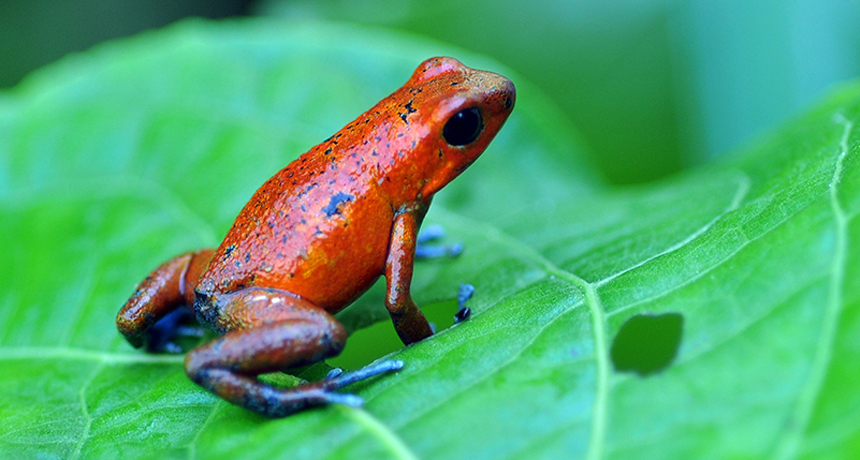Mama frog’s care includes a gift of poison

Strawberry poison frogs gain protection from predators with alkaloid chemicals sequestered from the arthropods they eat. Mama frogs feed eggs laced with those chemicals to their offspring, conferring protection on tadpoles.
Drriss & Marrionn/Flickr (CC BY-NC-SA 2.0)
- More than 2 years ago
Strawberry poison frogs (Oophaga pumilio) don’t create their own poison. The Central American frogs sequester the alkaloid chemicals from the mites, ants and other arthropods they eat and store it in glands on their skin. Predators that ignore the bright red “don’t eat me” warning pigmentation get a nasty surprise — a bad taste in their mouth, sickness or even death.
Tadpoles of a certain age also have some of those chemical defenses, and it’s a gift from mom, report Ralph Saporito, of John Carroll University in University Heights, Ohio, and colleagues in the March Ecology.
Female strawberry poison frogs lay their eggs in leaf litter, leaving them for the males to take care of for seven to 10 days. Papa frog keeps the eggs safe, and he pees on them to make sure they don’t lose their moisture. Mama frog then returns and moves the eggs into a pool of water formed in foliage. When the eggs hatch into tadpoles, she feeds each baby daily with unfertilized eggs for several weeks until the tadpoles transform into frogs.
Saporito and colleagues wanted to figure out when the frogs start acquiring their chemical defenses. They collected eggs, tadpoles and frogs from the La Selva Biological Station in Costa Rica, taking advantage of the fact that the frogs are just as willing to rear tadpoles in plastic cups as in natural foliage. They also collected the unfertilized eggs that mama frogs feed to their tadpole young. Some of the lab tadpoles were raised on the yolk of eggs from another species of frog — those eggs were guaranteed to contain no alkaloids.
The researchers then quantified the amount and types of alkaloid chemicals in eggs, tadpoles and frogs’ skin.
Adult frogs, as expected, had lots of alkaloids in their skin. Tadpoles raised in the lab on chemical-free yolk lacked the alkaloids. Fertilized eggs also had none. But the chemicals were found in tadpoles and young frogs, and the quantity and number of different alkaloids increased with age and size. Those chemicals, the researchers write, must be coming from the unfertilized, nutritious eggs.
Those alkaloids, even in levels much lower than seen in adult frogs, seem to provide some protection: When researchers presented predatory bullet ants (Paraponera clavata) with O. pumilio tadpoles and tadpoles of the nontoxic harlequin frog (Atelopus chiriquiensis), the ants were nine times more likely to attack the nontoxic prey.
Other amphibian species have been known to provision eggs with toxic defenses. The cane toad (Rhinella marina), for example, laces its eggs with chemicals called bufadienolides that protect the young through egg and tadpole development. But this is the first case in which an amphibian has been found provisioning its young with helpful poisons after hatching.
The exact age at which the young strawberry poison frog tadpoles start to store their poison isn’t quite clear yet. They acquire their red coloration around day 42 to 43, though, and that, the researchers write, might coincide with the time that they have become unpalatable or toxic.






